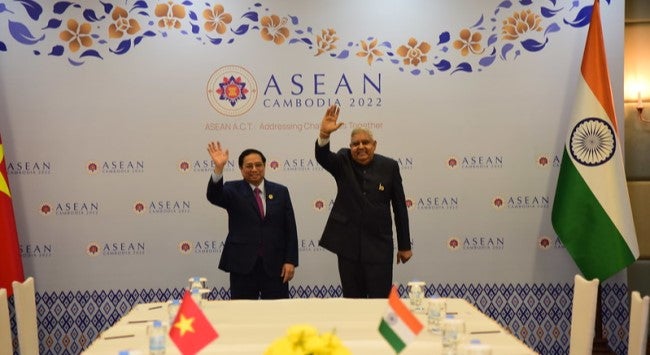Summary
The recent international economic outlook of the Association of Southeast Asian Nations has been defined and constrained by its relationship with the United States and China and their ongoing tensions. This conundrum provides opportunities for powers like India to expand their economic footprint in Southeast Asia.
The Association of Southeast Asian Nations (ASEAN) countries have been particularly susceptible to economic shocks that have produced significant changes in regional economic patterns. The organisation today finds itself in another conundrum due to spillovers from United States (US)-China economic and trade tensions that threaten to diminish ASEAN’s regional value chain structure, a fundamental pillar of regional economic growth. China and the US are the region’s most important partners and the largest export destinations for ASEAN countries. As a result, trade frictions between the US and China cascade back to Southeast Asian countries through regional supply chains.
ASEAN countries reside in an economic order that is and has been dominated by China and the US. The China-ASEAN economic ties have grown from US$9 billion (S$12.1 billion) in 1991 to US$685 billion (S$926.2 billion) in 2020; in fact, ASEAN surpassed the European Union as China’s largest trading partner in 2020. China-ASEAN trade has been facilitated by creating free trade zones, specifically the ASEAN-China Free Trade Area (ACFTA) signed in 2002. Both parties have since upgraded the ACFTA, which has helped develop value chains that organise production and trade. Chinese foreign direct investment (FDI) has been of particular importance for Southeast Asian growth. The region has become one of China’s major outbound investment destinations and sources of foreign direct investment in sectors such as manufacturing, agriculture, infrastructure, the digital and the green economy.
Like China, ASEAN’s exports to the US doubled between 2011 and 2020, expanding by more than US$ 100 billion (S$135.2 billion). American companies have been the leading source of FDI in Southeast Asia. With a stock of over US$226 billion (S$305.5 billion), US FDI in ASEAN has nearly doubled since 2008. Unlike China, the US has resisted ASEAN-wide economic and trade agreements, given that these agreements would have to be based on weak rules and standards acceptable to all ASEAN members. Instead, the US has developed rigorous relationships with select ASEAN countries like Singapore, Thailand and Malaysia based on their economic industries and interests. That said, given ASEAN’s economic size and prospects, US exports to the region should rise further, expanding from the current focus on Singapore and a few large economies to other countries.
Given the economic dominance of both the US and China in ASEAN, recent trade frictions between both powers have caused some displacement of production and investment away from Southeast Asia as countries adjust to hostile economic currents wrought by Beijing and Washington. For instance, between the years 2018-20, ASEAN’s share in the value of US imports rose by 2.6 per cent, the same amount by which China’s share declined. How do ASEAN countries navigate this tough economic conundrum? And what recourse do they have?
One way through which ASEAN can navigate this delicate situation and conundrum is by expanding economic and trade ties with major powers like India. India has engaged with ASEAN at both regional and sub-regional levels by signing economic cooperation agreements with different members. A framework agreement on comprehensive economic cooperation was signed in Bali in October 2003 between India and ASEAN to eliminate tariff barriers among all the members and eventually establish a free trade area in goods, services and investment. This was followed by a final agreement on trade in goods signed in Bangkok in 2009 and another on services and investments in New Delhi in 2015, but not all barriers have been removed. India has signed separate agreements with ASEAN members such as Thailand, Singapore and Malaysia to deepen economic integration with the region. As of 2021, ASEAN-India two-way trade hit US$92 billion (S$124.6 billion), up nearly 40 per cent from 2020, with considerable scope to grow. What areas should India and ASEAN prioritise to raise India’s economic footprint in Southeast Asia?
India and ASEAN can work to ease trade friction by simplifying rules that affect trade in goods. Doing this will also make it easier for India to become plugged into ASEAN’s regional value chains and make the latter less reliant on the US and China. To make it easier for firms, particularly small and medium-sized enterprises, both parties could sign a trade facilitation agreement that consists of robust trade facilitative practices, streamlined customs and regulatory procedures India’s efforts to boost connectivity can be directed through the Indo-Pacific Oceans , which was established at the 2019 East Asia Summit with the goal of creating a safe, secure, stable, prosperous and sustainable maritime domain where trade, connectivity and maritime transport are key priorities. Finally, ASEAN and India must focus on advancing digital connectivity.
Southeast Asia has emerged as one of the world’s most significant e-commerce growth opportunities, with over 70 million new online shoppers since the beginning of the pandemic. ASEAN members would be well-served to speedily ensure the development of a coherent and interoperable regulatory framework for the digital economy that would increase digital connectivity with India. India should motivate ASEAN members to double down on integration efforts and work to make their digital economies interoperable.
. . . . .
Dr Karthik Nachiappan is a Research Fellow at the Institute of South Asian Studies (ISAS), an autonomous research institute at the National University of Singapore (NUS). He can be contacted at isaskn@nus.edu.sg. The author bears full responsibility for the facts cited and opinions expressed in this paper.
Pic Credit: Ministry of External Affairs India Flickr Account
-
 More From :
More From :
-
 Tags :
Tags :
-
 Download PDF
Download PDF



